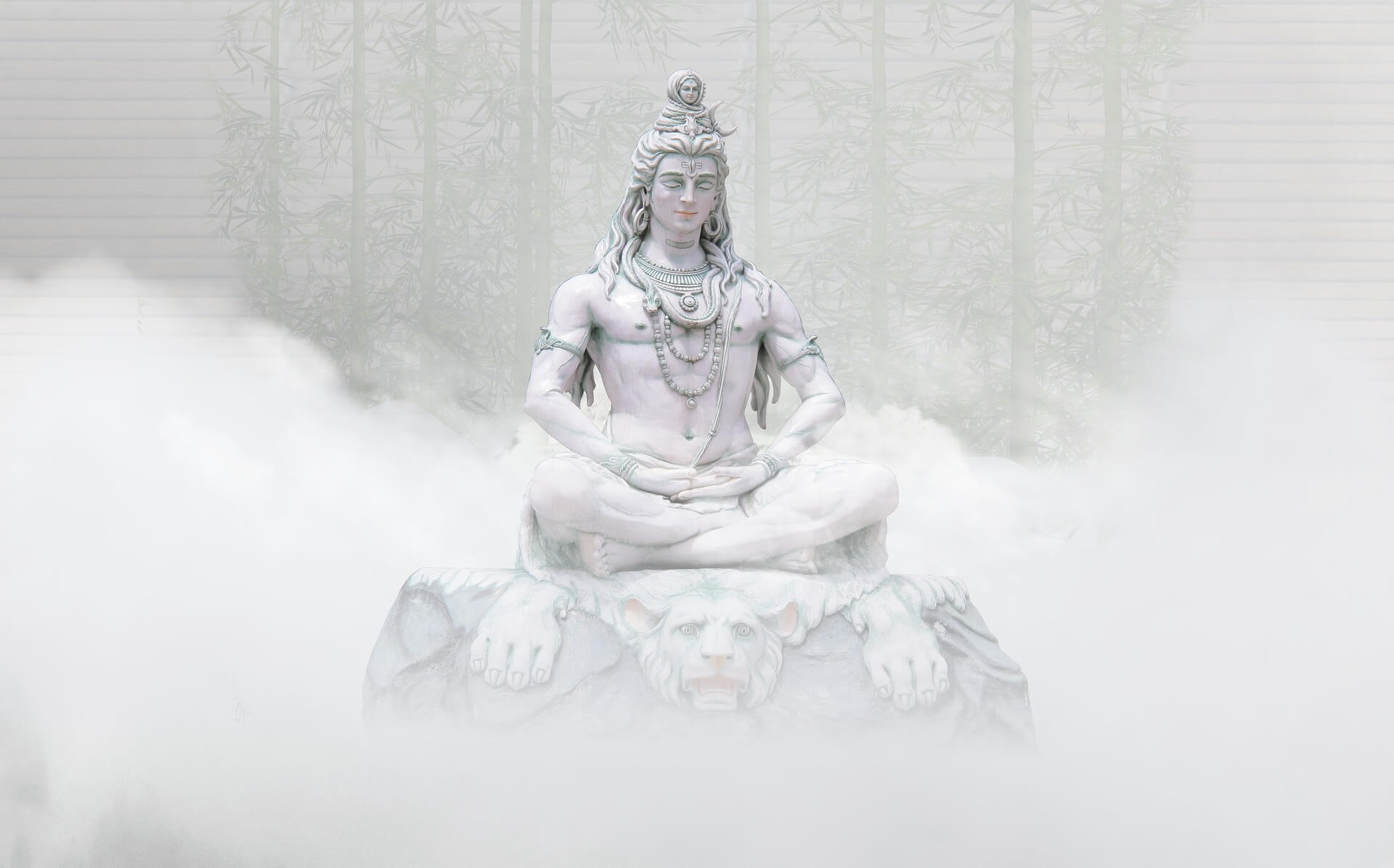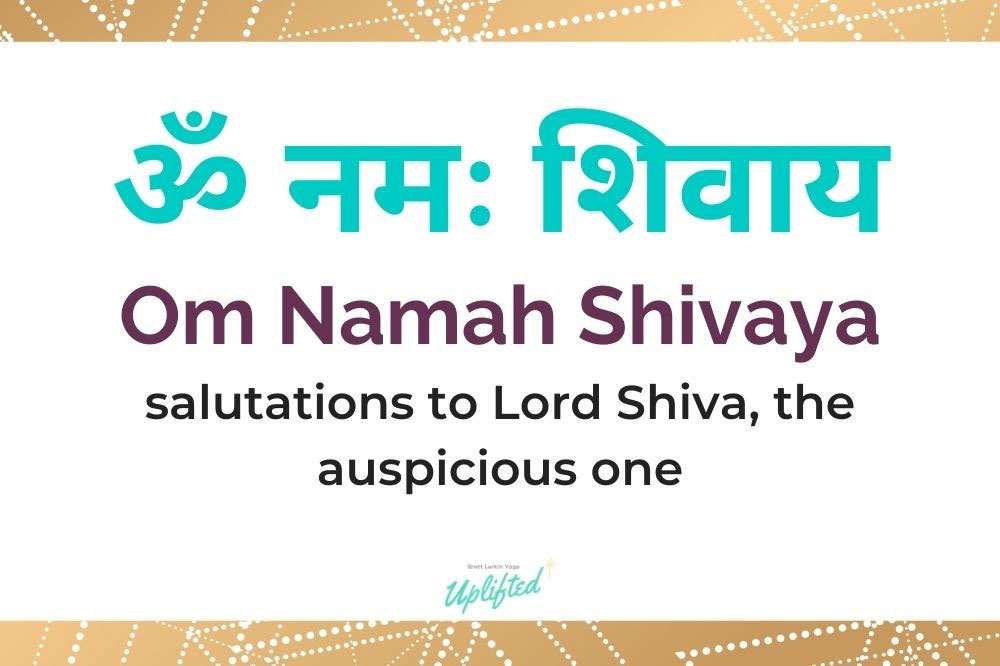
If you’ve ever been to a kirtan or attended a yoga retreat in some exotic land, then you may have heard blissed out yogis chanting ‘Om Namah Shivaya’.
And if you have, then you’ve been able to witness a very sacred and very special communion with Universal Consciousness.
You see, yoga is a spiritual practice that is thousands of years old and originates from South Asia.
In the West, however, Yoga is popular for its physical posture practice of asana sequences.
As you can imagine, a lot of the spirituality of this practice has been lost with the rise of gym memberships and #instafamous self-proclaimed yogis.
How it was originally intended, however, is as an intricate spiritual system involving many other aspects, such as moral and ethical philosophy, energy work, ritual and meditation.
One of these ancient and traditional practices is chanting mantras, which is not as well known as asana posture practice.
Mantras are sacred sounds that form prayers, or Divine sounds, which often do not have a translatable meaning in the modern context of language.
And since the purpose of Yoga is to unite with the ‘Inner Self’ or the ‘True Self’ (which is void of the ego), mantra chanting can be a powerful practice that helps us reach the ultimate goal of liberation from the ego.
By chanting the mantra with full focus, the mind becomes single-pointed. This deep level of concentration encourages a stillness of the mind and meditation can occur.
There are a variety of mantras for an array of purposes, such as reverence for Deities, meditation and cleansing the mind. So each mantra serves a different purpose.
And one of the most popular mantras of all is Om Namah Shivaya.
In this post, I want to break down the meaning of Om Namah Shivaya, why it matters, and how to use this mantra in your own daily practice.
Who is Lord Shiva?

Shiva is one of the most important figures in Hinduism and you’ve likely heard of him or seen images or figurines of him around your favorite yoga studio.
He is just one of three Gods in Hinduism, known as the holy trinity, and represents Universal Consciousness.
The Trimurti (holy trinity) is composed of three Gods; Shiva, Lord Vishnu and Brahma. Shiva is known as the destroyer, Vishnu the sustainer and Brahma the creator of the Universe.
Shiva is especially important; he is also known as Adiyogi Shiva, the God of Yoga, Meditation and the Arts. His abode is traditionally recognized as Mount Kailash, where he resided with his consort Parvarti and their children Ganesha and Kartikeya.
Because of his prominent place in Hinduism, and in Yoga, there are many rituals and devotional practices that are dedicated to him.
The Shiva Purana scripture, one of the most sacred scriptures in Hinduism, contains chapters on Yoga and Bhakti, of which mantra is an integral part of Devotional worship.
Not all factions of Hinduism regard Shiva as the most important God. Some worship Brahma and others worship Vishnu. The faction that worships Shiva is called Shaivism.
Shaivism is a major tradition within Hinduism where Shiva is regarded as ‘The Supreme God’ and the Siva Purana is the ancient text that holds information central to the theology behind Shaivism.
As such, God Siva is worshipped during the holy Hindu month of ‘shravan’, this is a particularly auspicious month to worship Lord Shiv, for Shiva devotees.
And “Om Namah Shivaya” is the powerful Hindu mantra that is offered in reverence to God Shiva.
On a deeper level, it also contains profound subtlety in its 5 syllables and is commonly known as the “five syllable mantra”. The significance of the number 5 comes up repeatedly in ancient texts and it has also been linked to the five elements (pancha bhoota). In this mantra, in particular, Na represents the water element, ma – water, si – fire, va – air and ya – ether.
It is also linked to the “Pancha Bodha Tatva”, which refers to the five aspects of God or Universal Consciousness.
But let’s get into the Om Namah Shivaya meaning, specifically.
Om Namah Shivaya (ॐ नमः शिवाय)

Om Namah Shivaya Meaning
Om Namah Shivaya is a Sanskrit mantra, which can be understood as a humble salutation to Shiva; “salutations to Lord Shiva, the auspicious one“.
Within Siddha Yoga lineage, in particular, ‘Om Namah Sivaya’ is used during initiation. (An initiation is like the official and traditional introduction into a sacred practice)
So what does each syllable mean?
“Om” is regarded as the ‘unstruck sound’; it is the sound from which the Universe is made, it can be thought of as the Divine in a representation of sound.
“Namah” represents “namaha”, which translates as salutations or bowing in reverence. In order for it to flow within the mantra, the ‘ha’ is silent.
“Shivaya” is a combination of Shiva with “ya” added to the end, which directs the salutation to Lord Shiva.
This Shiva Mantra is also commonly known as Panchakshara Mantra, Panchakshari Mantra or Namah Sivaya Mantra.
The Shiva mantra shows up a lot in ancient text, in the Shri Rudram hymn, in particular. The hymn is derived from two chapters of the Taittiriya Samhita (TS 4.5, 4.7) of Krishna Yajur Veda. The Yajurveda is an ancient Sanskrit scripture containing chants for worship rituals. The Om Namah Shivay Mantra is also present without the “Om” in the eighth hymn of Namakam (TS 4.5.8.1).
You’ll often see it written in a variety of ways, such as:
- Aum Namah Sivaya
- Om Namah Sivaya
- Om Namah Shivay
- Namaḥ Śivāya
Pronunciation
Pronunciation is important as potency is locked within the vibration of the syllables.
The sound of “Om” is divided into four parts and is actually commonly mispronounced as ‘ohm’.
The correct way to pronounce it is as AUM, which ends with silence after the first three sounds of A-U-M.
Each sound is broken down:
- A (aah) – as in apple
- U (uuu) – as in spoon.
- M (mmm) – as in Mother which is pronounced as a deep hum.
When we chant “Om” the ‘A’ and ‘U’ roll into one another which produces a sound similar to O, however it is distinctly the A and U combined
Benefits of Chanting Om Namah Shivaya Mantra

Within Hinduism, chanting Aum Namah Sivaya is seen as a healing practice for physical, mental and energetical purposes. It can be used to balance our energy and is a great preparation for deep meditation.
In the western world, however, mantra chanting can level up your meditation practice and make it even more powerful than meditation alone.
When practiced with full focus and presence, mantra chanting can become a meditation practice that has many benefits within itself.
A regular practice of chanting for meditation has the ability to increase focus and concentration. Not only that, but research has also found that meditation reduces stress, anxiety and depression, while also increasing creativity.
The chanting of “Om’ has been noted to stimulate the vagus nerve, which promotes a sense of wellbeing and relaxation.
Chanting could potentially make meditation accessible for those who have found other techniques less accessible.
The benefit of “Om Namah Shivay” also includes the ability to reveal the Inner Self, also known as the True Self.
How to Chant Om Namah Shivaya

1) Sit in an upright position with a straight spine. When chanting mantra, you must sit in a comfortable, stable, upright position. This can be on your Yoga mat in sukhasana, or on a chair if needs be. You may feel drawn to focus on energy in the Heart center.
2) Find a quiet place to practice. Although this mantra can be chanted anywhere, it is nice to find a quiet spot to practice when you begin in order to cultivate a deeper focus that develops over time. Finding a quiet spot to practice yoga, meditation, pranayama and mantra chanting allows you to draw the awareness inwards with minimal distractions outside of your practice. As your practice and ability to concentrate develops over time, your ability to witness distractions without following them with unwanted thoughts from a distracted mind also increases.
3) Repeat the Mantra multiple times. Recite and repeat the mantra for as long as it feels comfortable. Ensure that you stay focused and present with the mantra itself. You can build up the duration over time as your practice deepens and improves.
This powerful mantra can also be used during japa meditation – 108 is a particularly auspicious number within spirituality, so it is also recommended to chant the mantra “Om Namah Shivaya” 108 times.
4) You can chant out loud or silently. There are 5 different types of chanting – from vaachik (verbally out loud) to mansik (silently with no movement of the lips or tongue). Each is said to have varying potency.
5) Practice at sunrise or sunset. You can practice at any time throughout the day, however it is noted to be beneficial to practice at sunrise or sunset if possible
Resources
Next Steps
- If you’re interested in practical kriya yoga as a way to improve your daily life and relationships, check out my Yoga for Self Mastery course.
- Order my Yoga Life book for a practical guide to creating balance in your life through yoga.
- Check out my YouTube channel and find some yoga classes that you can try out for yourself!
Experience 3 Training Videos from Inside My 200-Hour Online YTT

YOU MIGHT ALSO LIKE
- What is Kriya Yoga? The Philosophy and Practice
- Uddiyana Bandha: Tapping Into Your Deep Core
- 4 Reasons Hasta Bandha Is Essential To Your Yoga Practice
- Vitarka Mudra: What It Is and How Do You Use It?
- Shakti Mudra: What It Is and How Do You Do It?
- Garuda Mudra: What It Is and How Do You Use It?
- Kali Mudra: What It Is and How Do You Do It?
- Shunya Mudra: What It Is and How Do You Do It?
- Varuna Mudra: What It Is and How Do You Use It?
- Vayu Mudra: What It Is and How Do You Use It?
- Samana Vayu: The Energy of Balance & How to Access It
- Apana Vayu: The Energy of Release & Surrender
- Udana Vayu: The Ascending Wind
- Prana Vayu: The Breath of Vitality
- Vyana Vayu: The Energetic Secret to Flow
Learn how to do 11 of the most popular yoga poses correctly. Free video + PDF download.











